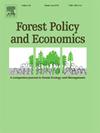孙德尔本斯红树林生态系统退化和恢复过程的参与式绘图
IF 4
2区 农林科学
Q1 ECONOMICS
引用次数: 0
摘要
红树林退化在许多(亚热带)沿海地区很常见,其原因是人为活动,如自然资源的过度采伐。额外的压力,如人口增长和与气候变化相关的海平面上升,正在影响孟加拉国的孙德尔本斯红树林生态系统。孙德尔本斯的保护和恢复对于维持生活在这个极度脆弱的沿海森林地区的数百万人的社会生态效益至关重要。迄今为止,很少从当地社区的角度评估生态系统退化和恢复战略。本研究旨在探讨孙德尔本斯当地居民的退化过程和社会生态恢复的机会。我们将DPSIR框架与公众参与地理信息系统(PPGIS)方法结合起来,研究了来自四个生计群体(第三产业、森林依赖、水产养殖和农业)的251名当地个人,以捕捉他们对红树林退化和恢复动态的空间理解。总共绘制了1297个退化和恢复响应措施的地理位置。受访者绘制了整个国家保护区森林退化的驱动因素,而恢复响应被认为集中在西部地区。过度采伐被认为是退化的重要驱动因素,红树林损失和水污染是主要压力。与农业、水产养殖和第三产业相比,以森林为生的人们更重视红树林退化的驱动因素、压力和影响。未来的研究应侧重于使森林管理者能够从空间上评估退化情况并促进社会可接受和由地方主导的生态系统恢复的综合方法。本文章由计算机程序翻译,如有差异,请以英文原文为准。
Participatory mapping of degradation and restoration processes in the Sundarbans mangrove ecosystem
Mangrove degradation is common in many (sub)tropical coastal areas, driven by anthropogenic activities such as overharvesting of natural resources. Additional pressures, such as increasing population, and sea level rise associated with climate change, are affecting the Sundarbans mangrove ecosystem in Bangladesh. The protection and restoration of the Sundarbans is important to maintain social-ecological benefits for millions of people living in this critically vulnerable coastal forest region. Ecosystem degradation and restoration strategies have so far rarely been assessed through the perspectives of local communities. Our study aimed to explore degradation processes and opportunities for social-ecological restoration among local people in the Sundarbans. We combined the DPSIR framework with a Public Participation GIS (PPGIS) approach, involving 251 local individuals among four livelihood groups (tertiary sector, forest-dependent, aquaculture, and agriculture), to capture their spatial understanding of mangrove degradation and restoration dynamics. A total of 1297 geolocations for degradation and restoration response measures were mapped. Respondents mapped drivers of degradation across the national reserve forest, while restoration responses were perceived to be clustered in the western region. Overharvesting of resources was considered as an important degradation driver, and mangrove loss and water pollution as dominant pressures. People with forest-dependent livelihoods placed greater importance on drivers, pressures and impacts of mangrove degradation than those in the agriculture, aquaculture and tertiary sectors. Future research should focus on integrated approaches that enable forest managers to spatially assess degradation and promote socially acceptable and locally-led ecosystem restoration.
求助全文
通过发布文献求助,成功后即可免费获取论文全文。
去求助
来源期刊

Forest Policy and Economics
农林科学-林学
CiteScore
9.00
自引率
7.50%
发文量
148
审稿时长
21.9 weeks
期刊介绍:
Forest Policy and Economics is a leading scientific journal that publishes peer-reviewed policy and economics research relating to forests, forested landscapes, forest-related industries, and other forest-relevant land uses. It also welcomes contributions from other social sciences and humanities perspectives that make clear theoretical, conceptual and methodological contributions to the existing state-of-the-art literature on forests and related land use systems. These disciplines include, but are not limited to, sociology, anthropology, human geography, history, jurisprudence, planning, development studies, and psychology research on forests. Forest Policy and Economics is global in scope and publishes multiple article types of high scientific standard. Acceptance for publication is subject to a double-blind peer-review process.
 求助内容:
求助内容: 应助结果提醒方式:
应助结果提醒方式:


